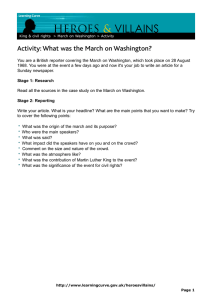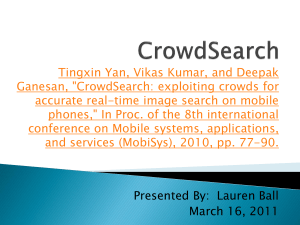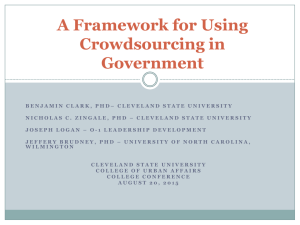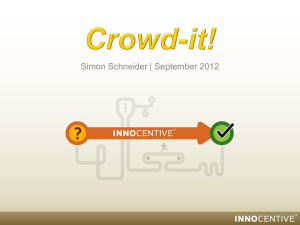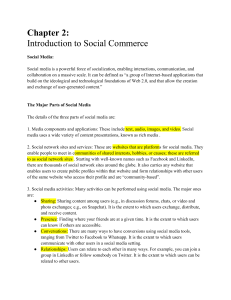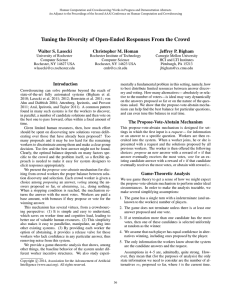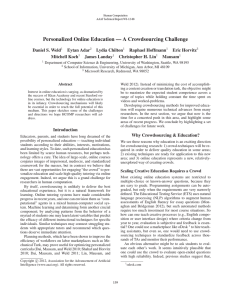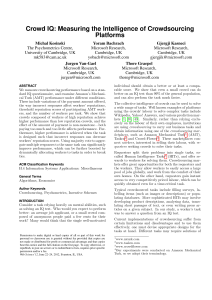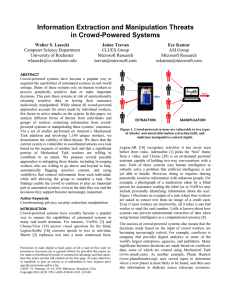Document 13861203
advertisement
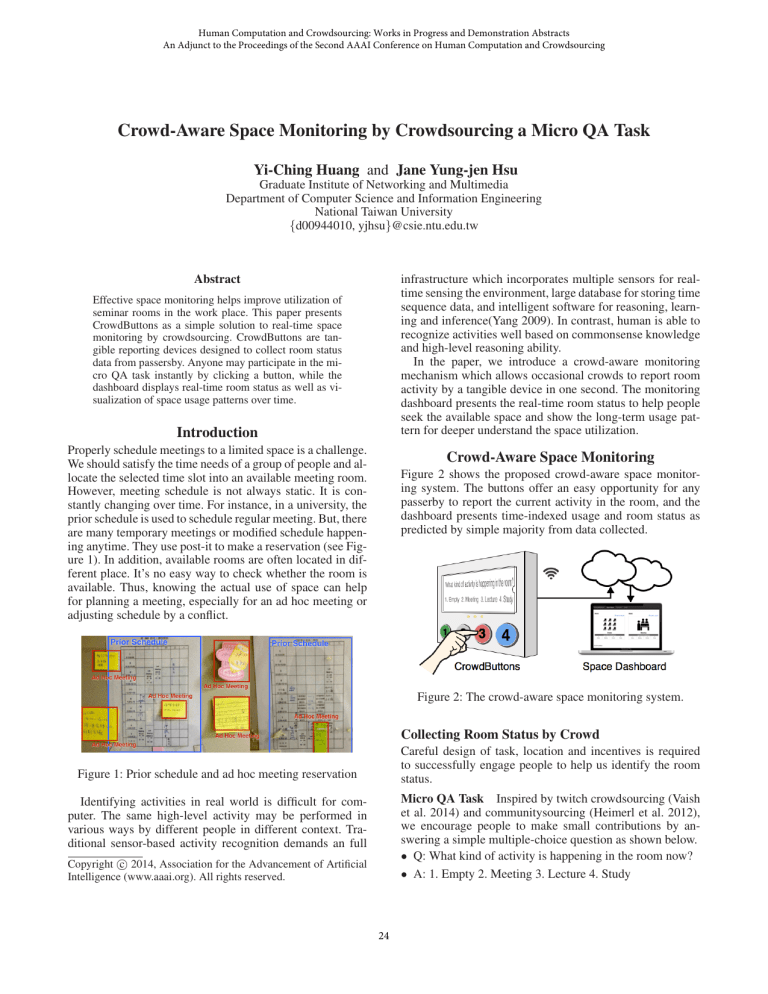
Human Computation and Crowdsourcing: Works in Progress and Demonstration Abstracts
An Adjunct to the Proceedings of the Second AAAI Conference on Human Computation and Crowdsourcing
Crowd-Aware Space Monitoring by Crowdsourcing a Micro QA Task
Yi-Ching Huang and Jane Yung-jen Hsu
Graduate Institute of Networking and Multimedia
Department of Computer Science and Information Engineering
National Taiwan University
{d00944010, yjhsu}@csie.ntu.edu.tw
Abstract
infrastructure which incorporates multiple sensors for realtime sensing the environment, large database for storing time
sequence data, and intelligent software for reasoning, learning and inference(Yang 2009). In contrast, human is able to
recognize activities well based on commonsense knowledge
and high-level reasoning ability.
In the paper, we introduce a crowd-aware monitoring
mechanism which allows occasional crowds to report room
activity by a tangible device in one second. The monitoring
dashboard presents the real-time room status to help people
seek the available space and show the long-term usage pattern for deeper understand the space utilization.
Effective space monitoring helps improve utilization of
seminar rooms in the work place. This paper presents
CrowdButtons as a simple solution to real-time space
monitoring by crowdsourcing. CrowdButtons are tangible reporting devices designed to collect room status
data from passersby. Anyone may participate in the micro QA task instantly by clicking a button, while the
dashboard displays real-time room status as well as visualization of space usage patterns over time.
Introduction
Properly schedule meetings to a limited space is a challenge.
We should satisfy the time needs of a group of people and allocate the selected time slot into an available meeting room.
However, meeting schedule is not always static. It is constantly changing over time. For instance, in a university, the
prior schedule is used to schedule regular meeting. But, there
are many temporary meetings or modified schedule happening anytime. They use post-it to make a reservation (see Figure 1). In addition, available rooms are often located in different place. It’s no easy way to check whether the room is
available. Thus, knowing the actual use of space can help
for planning a meeting, especially for an ad hoc meeting or
adjusting schedule by a conflict.
Crowd-Aware Space Monitoring
Figure 2 shows the proposed crowd-aware space monitoring system. The buttons offer an easy opportunity for any
passerby to report the current activity in the room, and the
dashboard presents time-indexed usage and room status as
predicted by simple majority from data collected.
Figure 2: The crowd-aware space monitoring system.
Collecting Room Status by Crowd
Careful design of task, location and incentives is required
to successfully engage people to help us identify the room
status.
Figure 1: Prior schedule and ad hoc meeting reservation
Micro QA Task Inspired by twitch crowdsourcing (Vaish
et al. 2014) and communitysourcing (Heimerl et al. 2012),
we encourage people to make small contributions by answering a simple multiple-choice question as shown below.
• Q: What kind of activity is happening in the room now?
• A: 1. Empty 2. Meeting 3. Lecture 4. Study
Identifying activities in real world is difficult for computer. The same high-level activity may be performed in
various ways by different people in different context. Traditional sensor-based activity recognition demands an full
Copyright c 2014, Association for the Advancement of Artificial
Intelligence (www.aaai.org). All rights reserved.
24
Crowd Reporting Device We developed the CrowdButtons, a physical reporting device that allows passersby to report the room activity in an instant. Each device comprises
one customizable question area, four colorful buttons numbered 1 through 4, three LED lights, together with an Arduino Yún microprocessor. The CrowdButtons are deployed
in common areas with many people passing by on a regular basis. As a person can easily recognize the activity in
the room, anyone can contribute by pressing a button and
the data will be submitted via WIFI to the server. The LED
lights provide visual feedback on reporting progress.
As summarized in Figure 5, crowd data performed competently in predicting room status with frequent reporting. Instead of jumping to the wrong conclusion as prior schedule,
incorrect predictions are avoided with the admission of missing data from the crowd.
Figure 5: Pilot experiment results
Space Dashboard
The dashboard is designed for presenting space usage data.
We use simple majority to decide the current room activity within a time interval. The most possible answer among
multiple candidates is selected by referring to the prior
schedule. If there is no report for a while, we assume the
room to be empty. Otherwise, the crowd data are aggregated
into hourly, daily and weekly reports. The detailed history
may be filtered by event type or location. We use multiple
and stacked bar chart to visualize the time-based data for
better understanding of the long-term trend.
Conclusion and Future Work
We designed and deployed a crowd-aware space monitoring system in a university department. The results show that
crowd data can effectively capture the actual space usage,
outperforming prior schedule. It is interesting to observe that
the building is always half empty and the unexpected empty
situation happens very often (see Figure 6).
A successful system relies on active participation of people for reporting room activity. We plan to make the CrowdButtons more interactive to encourage sustainable contributions from the crowd.
Pilot Experiment
We conducted a pilot experiment in a university and collected the crowdsourced data from CrowdButtons, ground
truth data from 4 volunteers and prior schedule from reservation calendar.
From March 20 to April 6, 2014, there are 584 contributions from CrowdButtons with very good data coverage as
shown in Figure 3 and Figure 4). We are able to observe the
correlation between the number of people and contributions.
We collected only 41 ground truth data from the recruited
volunteers during the same period, which indicates that unpaid volunteers made relatively few contributions with poor
data coverage.
Figure 6: Half empty situation
Acknowledgments
This work is supported in part by National Taiwan University, Intel Corporation and Ministry of Science and Education under Grants NTU103R7501, NSC102-2911-I-002001, NSC 101-2627-E-002 -002 and MOST 103-3113-E002-008.
References
Heimerl, K.; Gawalt, B.; Chen, K.; Parikh, T.; and Hartmann, B. 2012. Communitysourcing: Engaging local
crowds to perform expert work via physical kiosks. In Proceedings of the SIGCHI Conference on Human Factors in
Computing Systems, CHI ’12, 1539–1548. New York, NY,
USA: ACM.
Vaish, R.; Wyngarden, K.; Chen, J.; Cheung, B.; and Bernstein, M. S. 2014. Twitch crowdsourcing: Crowd contributions in short bursts of time crowd contributions in short
bursts of time. In Proceedings of the SIGCHI Conference on
Human Factors in Computing Systems, CHI ’14. ACM.
Yang, Q. 2009. Activity recognition: Linking low-level
sensors and high-level intelligence. In Proceedings of the
Twenty-First International Joint Conference on Artificial Intelligence (IJCAI ’09).
Figure 3: Average hourly contribution.
Figure 4: Daily contribution.
Preliminary results suggest that crowd data are more effective in capturing actual space usage than prior schedule.
25
